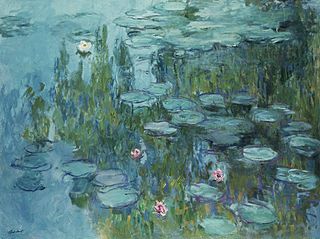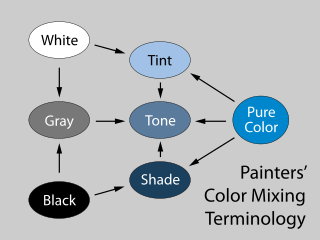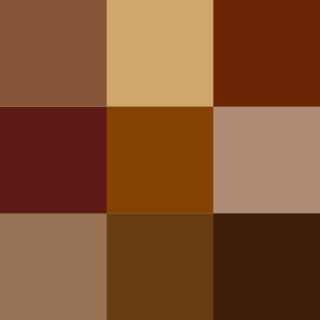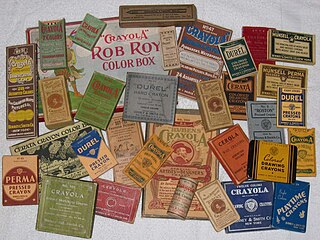
Cyan is the color between blue and green on the visible spectrum of light. It is evoked by light with a predominant wavelength between 490 and 520 nm, between the wavelengths of green and blue.

The Natural Color System (NCS) is a proprietary perceptual color model. It is based on the color opponency hypothesis of color vision, first proposed by German physiologist Ewald Hering. The current version of the NCS was developed by the Swedish Colour Centre Foundation, from 1964 onwards. The research team consisted of Anders Hård, Lars Sivik and Gunnar Tonnquist, who in 1997 received the AIC Judd award for their work. The system is based entirely on the phenomenology of human perception and not on color mixing. It is illustrated by a color atlas, marketed by NCS Colour AB in Stockholm.
In computing, on the X Window System, X11 color names are represented in a simple text file, which maps certain strings to RGB color values. It was traditionally shipped with every X11 installation, hence the name, and is usually located in <X11root>/lib/X11/rgb.txt. The web colors list is descended from it but differs for certain color names.
Color theory, or more specifically traditional color theory, is the historical body of knowledge describing the behavior of colors, namely in color mixing, color contrast effects, color harmony, color schemes and color symbolism. Modern color theory is generally referred to as Color science. While there is no clear distinction in scope, traditional color theory tends to be more subjective and have artistic applications, while color science tends to be more objective and have functional applications, such as in chemistry, astronomy or color reproduction. Color theory dates back at least as far as Aristotle's treatise On Colors. A formalization of "color theory" began in the 18th century, initially within a partisan controversy over Isaac Newton's theory of color and the nature of primary colors. By the end of the 19th century, a schism had formed between traditional color theory and color science.

This is an index of color topic-related articles.

A color wheel or color circle is an abstract illustrative organization of color hues around a circle, which shows the relationships between primary colors, secondary colors, tertiary colors etc.

A spectral color is a color that is evoked by monochromatic light, i.e. either a spectral line with a single wavelength or frequency of light in the visible spectrum, or a relatively narrow spectral band. Every wave of visible light is perceived as a spectral color; when viewed as a continuous spectrum, these colors are seen as the familiar rainbow. Non-spectral colors are evoked by a combination of spectral colors.

A chemically pure and structurally perfect diamond is perfectly transparent with no hue, or color. However, in reality almost no gem-sized natural diamonds are absolutely perfect. The color of a diamond may be affected by chemical impurities and/or structural defects in the crystal lattice. Depending on the hue and intensity of a diamond's coloration, a diamond's color can either detract from or enhance its value. For example, most white diamonds are discounted in price when more yellow hue is detectable, while intense pink diamonds or blue diamonds can be dramatically more valuable. Of all colored diamonds, red diamonds are the rarest. The Aurora Pyramid of Hope displays a spectacular array of naturally colored diamonds, including red diamonds.
In many languages, the colors described in English as "blue" and "green" are colexified, i.e., expressed using a single umbrella term. To render this ambiguous notion in English, linguists use the blend word grue, from green and blue, a term coined by the philosopher Nelson Goodman—with an unrelated meaning—in his 1955 Fact, Fiction, and Forecast to illustrate his "new riddle of induction".

Basic Color Terms: Their Universality and Evolution is a book by Brent Berlin and Paul Kay. Berlin and Kay's work proposed that the basic color terms in a culture, such as black, brown, or red, are predictable by the number of color terms the culture has. All cultures have terms for black/dark and white/bright. If a culture has three color terms, the third is red. If a culture has four, it has either yellow or green.

In color theory, a tint is a mixture of a color with white, which increases lightness, while a shade is a mixture with black, which increases darkness. Both processes affect the resulting color mixture's relative saturation. A tone is produced either by mixing a color with gray, or by both tinting and shading. Mixing a color with any neutral color reduces the chroma, or colorfulness, while the hue remains unchanged.
The concept of linguistic relativity concerns the relationship between language and thought, specifically whether language influences thought, and, if so, how. This question has led to research in multiple disciplines—including anthropology, cognitive science, linguistics, and philosophy. Among the most debated theories in this area of work is the Sapir–Whorf hypothesis. This theory states that the language a person speaks will affect the way that this person thinks. The theory varies between two main proposals: that language structure determines how individuals perceive the world and that language structure influences the world view of speakers of a given language but does not determine it.

The ISCC–NBS System of Color Designation is a system for naming colors based on a set of 13 basic color terms and a small set of adjective modifiers. It was first established in the 1930s by a joint effort of the Inter-Society Color Council (ISCC), made up of delegates from various American trade organizations, and the National Bureau of Standards (NBS), a US government agency. As suggested in 1932 by the first chairman of the ISCC, the system's goal is to be "a means of designating colors in the United States Pharmacopoeia, in the National Formulary, and in general literature ... such designation to be sufficiently standardized as to be acceptable and usable by science, sufficiently broad to be appreciated and used by science, art, and industry, and sufficiently commonplace to be understood, at least in a general way, by the whole public." The system aims to provide a basis on which color definitions in fields from fashion and printing to botany and geology can be systematized and regularized, so that each industry need not invent its own incompatible color system.

Varieties of the color blue may differ in hue, chroma, or lightness, or in two or three of these qualities. Variations in value are also called tints and shades, a tint being a blue or other hue mixed with white, a shade being mixed with black. A large selection of these colors is shown below.

Variations of gray or grey include achromatic grayscale shades, which lie exactly between white and black, and nearby colors with low colorfulness. A selection of a number of these various colors is shown below.

Shades of brown can be produced by combining red, yellow, and black pigments, or by a combination of orange and black—illustrated in the color box. The RGB color model, that generates all colors on computer and television screens, makes brown by combining red and green light at different intensities. Brown color names are often imprecise, and some shades, such as beige, can refer to lighter rather than darker shades of yellow and red. Such colors are less saturated than colors perceived to be orange. Browns are usually described as light or dark, reddish, yellowish, or gray-brown. There are no standardized names for shades of brown; the same shade may have different names on different color lists, and sometimes one name can refer to several very different colors. The X11 color list of web colors has seventeen different shades of brown, but the complete list of browns is much longer.
This article provides introductory information about the RGB, HSV, and HSL color models from a computer graphics perspective. An introduction to colors is also provided to support the main discussion.
The Color Naming System (CNS) is a systematic notation for named colors for computer applications using English terms created by Berk et al. in 1982.

Since the introduction of Crayola drawing crayons by Binney & Smith in 1903, more than two hundred colors have been produced in a wide variety of assortments. The line has undergone several major revisions, notably in 1935, 1949, 1958, and 1990. Numerous specialty crayons have also been produced, complementing the basic Crayola assortment.




















